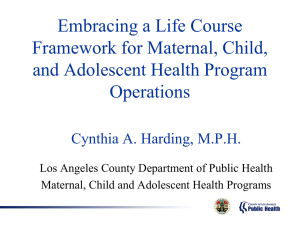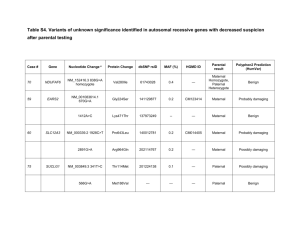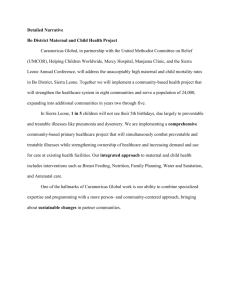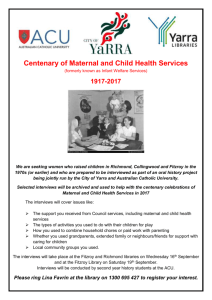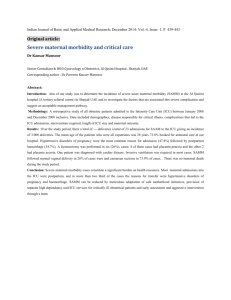Technical Brief on addressing Transport Barriers to MNCH services
advertisement
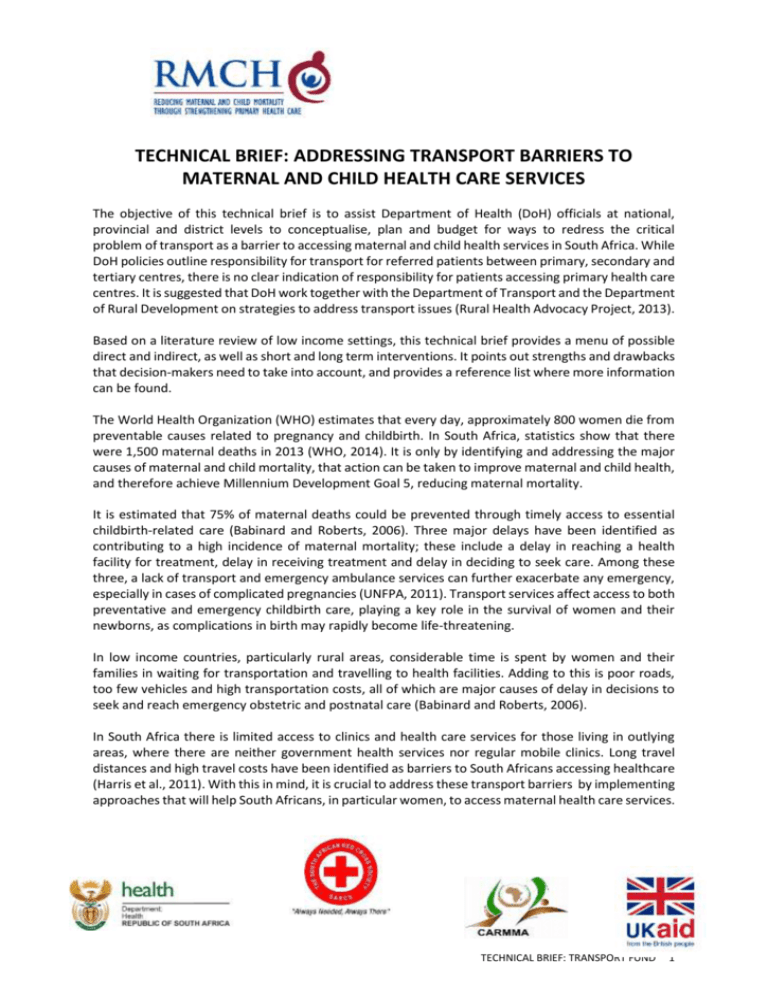
TECHNICAL BRIEF: ADDRESSING TRANSPORT BARRIERS TO MATERNAL AND CHILD HEALTH CARE SERVICES The objective of this technical brief is to assist Department of Health (DoH) officials at national, provincial and district levels to conceptualise, plan and budget for ways to redress the critical problem of transport as a barrier to accessing maternal and child health services in South Africa. While DoH policies outline responsibility for transport for referred patients between primary, secondary and tertiary centres, there is no clear indication of responsibility for patients accessing primary health care centres. It is suggested that DoH work together with the Department of Transport and the Department of Rural Development on strategies to address transport issues (Rural Health Advocacy Project, 2013). Based on a literature review of low income settings, this technical brief provides a menu of possible direct and indirect, as well as short and long term interventions. It points out strengths and drawbacks that decision-makers need to take into account, and provides a reference list where more information can be found. The World Health Organization (WHO) estimates that every day, approximately 800 women die from preventable causes related to pregnancy and childbirth. In South Africa, statistics show that there were 1,500 maternal deaths in 2013 (WHO, 2014). It is only by identifying and addressing the major causes of maternal and child mortality, that action can be taken to improve maternal and child health, and therefore achieve Millennium Development Goal 5, reducing maternal mortality. It is estimated that 75% of maternal deaths could be prevented through timely access to essential childbirth-related care (Babinard and Roberts, 2006). Three major delays have been identified as contributing to a high incidence of maternal mortality; these include a delay in reaching a health facility for treatment, delay in receiving treatment and delay in deciding to seek care. Among these three, a lack of transport and emergency ambulance services can further exacerbate any emergency, especially in cases of complicated pregnancies (UNFPA, 2011). Transport services affect access to both preventative and emergency childbirth care, playing a key role in the survival of women and their newborns, as complications in birth may rapidly become life-threatening. In low income countries, particularly rural areas, considerable time is spent by women and their families in waiting for transportation and travelling to health facilities. Adding to this is poor roads, too few vehicles and high transportation costs, all of which are major causes of delay in decisions to seek and reach emergency obstetric and postnatal care (Babinard and Roberts, 2006). In South Africa there is limited access to clinics and health care services for those living in outlying areas, where there are neither government health services nor regular mobile clinics. Long travel distances and high travel costs have been identified as barriers to South Africans accessing healthcare (Harris et al., 2011). With this in mind, it is crucial to address these transport barriers by implementing approaches that will help South Africans, in particular women, to access maternal health care services. TECHNICAL BRIEF: TRANSPORT FUND 1 It should be noted that barriers to transport are diverse and complex, with some being more systemic than others. Transport barriers can be tackled directly by providing transport to the poor and marginalised or indirectly by providing mobile clinics or waiting homes; and interventions can be short or long term. With this in mind, three approaches to enable women to access healthcare services have been identified, these include: public/private partnerships and transportation programmes; specialised health transport (i.e., ambulances); and transport funds or transport vouchers. The main benefit of all three approaches is that they have shown to reduce maternal and infant mortality by enabling women to better access health facilities in a timely manner, especially in an emergency. Furthermore, these approaches help create partnerships, as well as build capacity and community awareness about maternal health issues. On the other hand, these approaches require commitment from various stakeholders, capacity building for drivers and funding associated with high running costs. 1. PUBLIC/PRIVATE PARTNERSHIPS AND TRANSPORTATION PROGRAMMES Public/private partnerships and transportation programmes aim to improve the availability of emergency transport and therefore address barriers to access. These programmes focus on training and encouraging local taxi drivers to transport women to health centres, so that they can access the required healthcare services. Examples have been identified in Ghana (UNFPA, 2011) and in Nigeria (Transaid, 2009). These programmes have proven to be highly effective in low resource and developing countries with low uptake of healthcare services (Theophilus, 2013). Public/private partnerships and transportation programmes are examples of ways to improve the availability of emergency transport for women needing to access health facilities. These programmes build partnership and capacity among taxi drivers, but if not well publicised and monitored they can have little impact in getting women to health facilities. Taking this into consideration, the following issues should be considered when implementing such programmes: Accountability, commitment and supervision: Transportation programmes that use voucher systems and schemes should be protected, monitored and reinforced because they serve as an accountability tool for tracking referrals and benefits for drivers (UNFPA, 2011). All committees involved in the set-up of such initiatives or partnerships need to continue reinforcing their commitment, and orient new stakeholders and staff on the benefits of such programmes (UNFPA, 2011). Also, effective supervision should be set up to ensure that drivers are providing a quality service (Theophilus, 2013). Indicators: Transportation programmes need to determine clear and attributable indicators to better support the effectiveness and impact of the initiative (UNFPA, 2011). Training: Health facility staff members need to be continually trained and sensitised on how to prioritise taxi drivers, how to consistently provide vouchers and how to positively interact with taxi drivers (UNFPA, 2011). Taxi drivers need to be trained on basic first aid response, how to handle expectant mothers and emergency child birth, safe driving practices, etc. In order to reduce costs, training using peer groups should be implemented (Theophilus, 2013). Partnering with government: Public-private partnerships should be set up with government (i.e., Department of Transport and the Department of Health), as this will improve healthcare utilisation and increase uptake of healthcare services (Theophilus, 2013). 2. SPECIALISED HEALTH TRANSPORT (AMBULANCES) TECHNICAL BRIEF: TRANSPORT FUND 2 Specialised health transport, such as ambulances are various forms of locally appropriate transport. In Somalia donkey cart ambulances are the most effective way of transporting women to the nearest health facility (CARMMA, 2013), while in Zambia bicycle ambulances (Health Partners International, 2013), in Malawi motorcycle ambulances (Hofman et al., 2008) and in South Africa car ambulances (Schoon, 2013) have also proven to be very effective. These forms of transport are designed to help women in isolated areas who have poor access to health services or who are unable to afford transport services to reach their nearest health facility to obtain maternal health services. There are many benefits of having specialised health transport available to assist women in an emergency to access health facilities without delay. However, these forms of transport are also costly and appropriate training is required for the drivers, in order to ensure that women are able to reach the health facility safely. In order to ensure that specialised health transport is successfully implement the following needs to be considered: Training: It is essential that there is adequate operator training, safety training, management training and maintenance training prior to the introduction of any of the various modes of specialised health transport (Transaid, 2010). Affordability: In resource-poor countries motorcycle ambulances at rural health centres are a useful means of referral for emergency obstetric care, and a relatively cheap option for the health sector (Hofman et al., 2008). Dedicated vehicles for maternity transfers: Health authorities should prioritise inter-hospital transport vehicles within their budgets to ensure access of the pregnant population to appropriate care and where feasible, to assign dedicated vehicles to maternity transfers (Schoon, 2013). 3. TRANSPORT FUND OR TRANSPORT VOUCHER A Transport Fund or Transport Voucher is a scheme where women are given financial support (cash or a voucher) to assist them with transport to the nearest health facility in order to receive maternal healthcare services. In many instances this allows them to use local transport to and from the health facility for antenatal, delivery and postnatal care. Several initiatives have been implemented in Bangladesh (Laurel et al., 2010; Ahmed & Khan, 2011), India (De Costa, et al., 2009), Nepal (UNICEF, 2013), Sierra Leone (Amnesty International, 2009), Uganda (Pariyo et al., 2011) and South Africa (Durden, 2014). Implementing a transport fund or transport voucher scheme has shown to have increased community awareness about maternal health and provide economic benefits to transport providers, along with increasing women’s to access health facilities. However, these schemes are dependent on external funding and are a short-term measure to assist poor women, and not a solution to maternal mortality in low-income settings. In order to ensure sustainability of a transport fund or transport voucher programme, the following suggestions are made: Capacity and Cost: Two important things to consider in setting up an initiative such as a transport fund or transport voucher is the capacity to run the scheme and the cost of running the scheme. Proper running of the scheme requires that there is a clear system for paying the providers, this payment needs to be done regularly and frequently (Pariyo et al., 2011). TECHNICAL BRIEF: TRANSPORT FUND 3 Community Mobilisation Fund: Because government may have difficulties in meeting the financial requirements and donors get fatigued over time, there is a need to mobilise the community to contribute to the running of such a programme. One option could include the creation of community mobilisation fund perhaps through community insurance schemes. Families could then be encouraged to make periodic contributions that would cater for the transport needs of the mother and the newborn. This insurance scheme would then liaise with local transport providers and discuss pricing and service arrangements (Pariyo et al., 2011). Partnership: Implementing a transport fund or transport voucher in collaboration with the district heath team, organising regular meetings with stakeholders at district level to discuss implementation and how to address challenges, and discussing new ways to sustain the fund can also be beneficial (Pariyo et al., 2011). Community involvement: Those identifying people in need must be embedded in the community and have a clear idea of the context and the community needs (Durden, 2014) Fund management: There should be direct, hands-on management of the fund, anti-fraud measures must be put in place, strong support and follow-up processes for clients must be instituted, and good record-keeping and data gathering processes should be adhered to (Durden, 2014). Short-term assistance: The fund should be seen as once-off or short-term assistance for people in need, until more sustainable support from government services can be secured (Durden, 2014). ALTERNATIVES TO TRANSPORT PROGRAMMES Mobile clinics: Enabling more mobile clinics to travel to outlying areas can be useful in addressing some of the transport barriers faced by women (Durden, 2014). Building clinics: Building more clinics to service areas where there are large spread-out populations can be beneficial (Durden, 2014). Maternity waiting homes: If the number of emergency vehicles cannot be increased nationally, then other interventions, such as the establishment of maternity waiting homes, should continue (Schoon, 2013; Durden, 2014). Work-site clinics: Encouraging and supporting employers hosting work-site clinics (Durden, 2014). Free government-funded modes of transport: Improving free government-funded modes of transport to government services, and enhancing the availability of ambulances (Durden, 2014). Job creation and income-generating opportunities: Creating jobs and income-generating opportunities, so that women are able to earn money so they can afford public transport themselves (Durden, 2014). Taking into account the consideration the above mentioned experiences and considerations has the potential to provide greater access to women over the longer-term to healthcare services. Without either short or long term measures to improve access to maternal and child health, health risks to women who are pregnant or caring for babies will increase. The effects on women with HIV are exacerbated as they are at greater risk of falling ill or dying due to late treatment, and have the potential to pass on the virus to their unborn child. This in turn impacts on the health of their children TECHNICAL BRIEF: TRANSPORT FUND 4 and the wider community. Investing in improved access to healthcare at this earlier stage by addressing barriers to transport also has the potential to reduce the overall financial and human resource burden on the South Africa health system. REFERENCES Ahmed, S. and Khan, M. 2011. “A maternal health voucher scheme: what have we learned from the demand-side financing scheme in Bangladesh?” Health Policy and Planning 26: 25-32. Amnesty International. 2009. “Out of Reach: The cost of maternal health in Sierra Leone.” Retrieved September 8, 2014, from http://www.amnestyusa.org/sites/default/files/pdfs/outofreach.pdf. Babinard, Julie and Roberts, Peter. 2006. “Maternal and Child Mortality Development Goals: What Can the Transport Sector Do?” Retrieved September 8, 2014, from https://www.ssatp.org/sites/ssatp/files/pdfs/Topics/gender/tp12_maternal_health%5b1%5d.pdf. CARMMA. 2013. “Has Somalia’s Health System found a Breakthrough to Address High Maternal Mortality Rates using the Somali Donkey?” Retrieved September 11, 2014, from http://www.carmma.org/fr/update/has-somalia%E2%80%99s-health-system-found-breakthroughaddress-high-maternal-mortality-rates-using. De Costa, A., Patil, R., Kushwah, S. S., and Diwan, V. K. 2009. “Financial incentives to influence maternal mortality in a low-income setting: making available ‘money to transport’ – experiences from Amarpatan, India. Global Health Action DOI:10.3402/gha.v2i0.1866. Durden, E. 2014. “A Narrative Report on the KZN Red Cross Transport Fund”. Durban, South Africa. Health Partners International (HPI). 2013. Linking communities to maternal health care via an Emergency Transport System. Retrieved September 12, 2014, from http://www.healthpartnersint.co.uk/our_projects/documents/MAMaZPolicyBrief-ETS_000.pdf. Hofman, J., Dzimadzi, C., Lungu, K., Ratsma, E. and Hussein, J. 2008. “Motorcycle ambulances for referral of obstetric emergencies in rural Malawi: Do they reduce delay and what do they cost?” International Journal of Gynecology and Obstetrics 102: 191-197. Laurel, H., Nguyen, H., Sloan, N., Miner, S., Magvanjav, O. et al. 2010. “Economic Evaluation of Demand-Side Financing (DSF) for Maternal Health in Bangladesh.” Retrieved September 9, 2014, from http://reliefweb.int/sites/reliefweb.int/files/resources/Bangladesh%20DSF%20evaluation_FINAL_Fe b%202010.pdf. Pariyo, G., Mayora, C., Okui, O., Ssengooba, F., Peters, D. et al. 2011. “Exploring new health markets: experiences from informal providers of transport for maternal health services in Eastern Uganda.” BMC International Health and Human Rights 11 (Suppl. 1): S10. Rural Health Advocacy Project (2013) The Role and Impact Of Transport On Rural Communities Accessing The State Health Care System In South Africa. Retrieved 5 November, 2014, from http://www.rhap.org.za/wp-content/uploads/2014/02/RHAP-Position-Paper. Schoon, M. G. 2013. Impact of inter-facility transport on maternal mortality in the Free State Province. South African Medical Journal 103(8): 534-537. TECHNICAL BRIEF: TRANSPORT FUND 5 Theophilus, I. 2013. “Promoting Emergency Transport Scheme in Safe Delivery Service: A case study of Gombe State, Nigeria.” PPT presentation presented at the 2013 Global Maternal Health Conference: Improving Quality of Care, Arusha, Tanzania. Transaid. 2010. “Assessing Access to Health Services for Rural Communities.” Retrieved September 21, 2014, from http://www.transaid.org/images/resources/20%20Transaid%20Technical%20Case%20Study%20%20Assessing%20Access%20to%20Health%20Services%20for%20Rural%20Communities.pdf. Transaid. 2009. “Northern Nigeria Emergency Transport Scheme” Retrieved September 11, 2014, from http://www.amddprogram.org/sites/default/files/Transaid_Technical%20Case%20Study_Northern% 20Nigeria%20ETS.pdf. UNFPA. 2011. “Innovative Approaches to Referrals of Emergency Obstetric Cases – Working in Collaboration with Ghana Private Roads and Transport Unions (GPRTU).” Retrieved September 10, 2014, from http://ghana.unfpa.org/assets/user/file/TRANSPORT_UNION.pdf. UNICEF. 2013. “Innovative Approaches to Maternal and Newborn Health: Compendium of Case Studies.” Retrieved September 8, 2014, from http://www.unicef.org/health/files/Innovative_Approaches_MNH_CaseStudies-2013.pdf. World Health Organization (WHO). 2014. “Maternal Mortality Country Profiles.” Retrieved October 7, 2014, from http://www.who.int/gho/maternal_health/countries/en/#S. TECHNICAL BRIEF: TRANSPORT FUND 6




